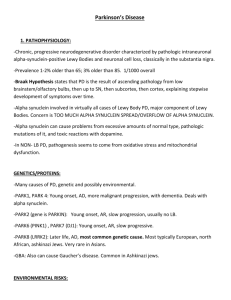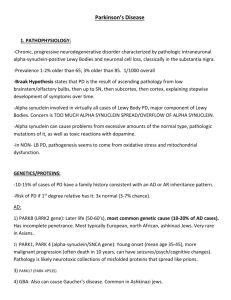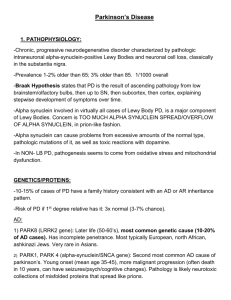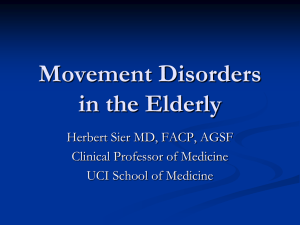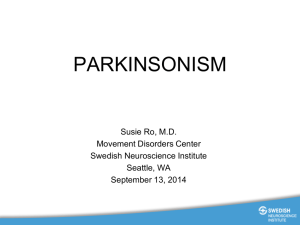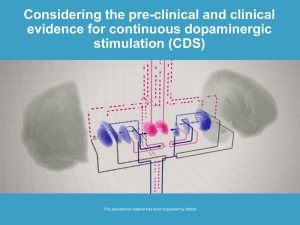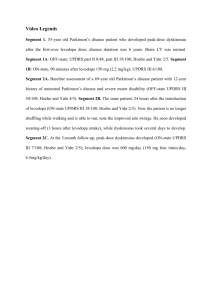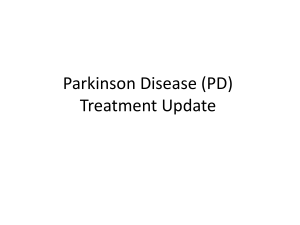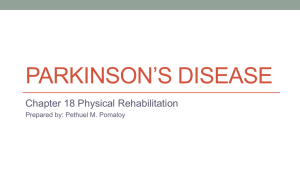Parkinson`s Disease 1. PATHOPHYSIOLOGY
advertisement
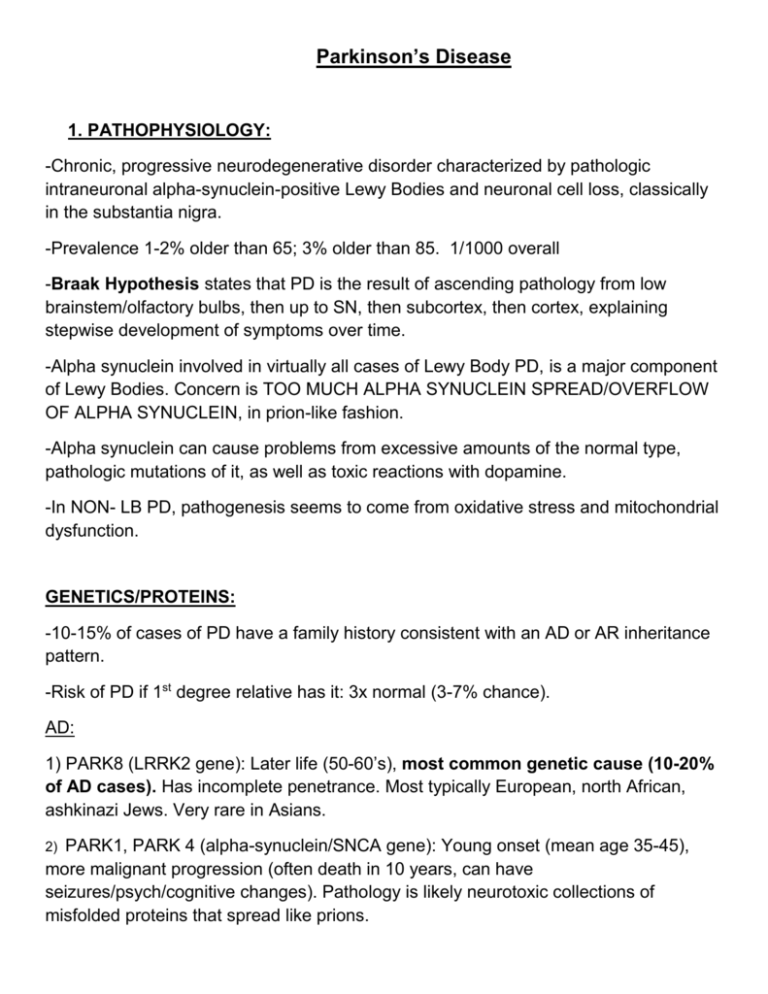
Parkinson’s Disease 1. PATHOPHYSIOLOGY: -Chronic, progressive neurodegenerative disorder characterized by pathologic intraneuronal alpha-synuclein-positive Lewy Bodies and neuronal cell loss, classically in the substantia nigra. -Prevalence 1-2% older than 65; 3% older than 85. 1/1000 overall -Braak Hypothesis states that PD is the result of ascending pathology from low brainstem/olfactory bulbs, then up to SN, then subcortex, then cortex, explaining stepwise development of symptoms over time. -Alpha synuclein involved in virtually all cases of Lewy Body PD, is a major component of Lewy Bodies. Concern is TOO MUCH ALPHA SYNUCLEIN SPREAD/OVERFLOW OF ALPHA SYNUCLEIN, in prion-like fashion. -Alpha synuclein can cause problems from excessive amounts of the normal type, pathologic mutations of it, as well as toxic reactions with dopamine. -In NON- LB PD, pathogenesis seems to come from oxidative stress and mitochondrial dysfunction. GENETICS/PROTEINS: -10-15% of cases of PD have a family history consistent with an AD or AR inheritance pattern. -Risk of PD if 1st degree relative has it: 3x normal (3-7% chance). AD: 1) PARK8 (LRRK2 gene): Later life (50-60’s), most common genetic cause (10-20% of AD cases). Has incomplete penetrance. Most typically European, north African, ashkinazi Jews. Very rare in Asians. PARK1, PARK 4 (alpha-synuclein/SNCA gene): Young onset (mean age 35-45), more malignant progression (often death in 10 years, can have seizures/psych/cognitive changes). Pathology is likely neurotoxic collections of misfolded proteins that spread like prions. 2) 3) PARK17 (PARK-VPS35) 4) GBA: Also can cause Gaucher’s disease. Common in Ashkinazi jews. AR: 1) PARK2 (PARKIN gene): Usual disease onset <35 (majority of cases of PD with onset <20 are due to this gene), slowly progressive. 50% of cases of AR PD, and 15% of apparently sporadic PD with onset <age 45. Often with early lower extremity dystonia and hyperreflexia. Dopamine-responsive. 2) PARK6 (PINK1 gene): Young onset, slowly progressive, 1-8% of young-onset cases. 3) PARK7 (DJ1 gene): Young onset, slowly progressive, 1-2% of young-onset cases. ENVIRONMENTAL RISKS: -Pesticides (OR 2.4) -Oxidative stress -Protective factors include smoking (???), coffee, alcohol, etc. 2. CARDINAL FEATURES: 1. Bradykinesia (Slowness or smallness of movement) -Symptoms: slowed gait, decreased volume of voice or size of handwriting, trouble with manual dexterity (buttoning buttons/zipping zippers etc). -Signs: hypophonia, mask-like facies, decreased blink rate, slow shuffling gait with decreased arm swing, decrement/slowing to finger-tap or heel-stomp, narrow-based gait, festination, freezing. 2. Rigidity: -Symptoms: trouble getting up from soft couches/chairs, general stiffness, trouble turning in bed, MSK pain. -Signs: cogwheeling (tremor + rigidity), increased tone, extreme neck flexion, scoliosis, striatal limb deformities, postural reflex loss, stooped posture. 3. Resting Tremor -Symptoms/characteristics: Can be present at same times as action tremor; tends to start unilaterally, but can spread bilaterally to involve legs and chin; classically slowly builds in frequency at rest, particularly when patient distracted; can be brought out when walking and with stress. Can be suppressed with concentration or by using the hand. Can be intermittent at first, but becomes constant as disease progresses. Can also have sense of “internal” shaking” (vs. dyskinesias) -Signs: Rhythmic, involuntary, low frequency (4-6 Hz), oscillatory, and often pill-rolling. Presenting symptom in 50-70% of patients. Can also get “re-emergent” quality of oscillating tremor with posture/action. 4. Postural instability: -Symptoms: Unsteadiness, falls, freezing, difficulty with gait. -Signs: Pull test/retropulsion test. 5. Sustained and clear response to levodopa: -Get up to as much as total daily dose of 900mg for at least 2 weeks (lower dose ok, if clear benefit) -Exception to this rule: tremor-predominant PD is less responsive. -Parkinson Plus syndromes will often not respond to sinemet, respond poorly/inadequately, or have wearing off of benefit quickly. 3. Other components of the disease to ask about on history: Meds effective enough? Things you are limited in doing that you want to do? Meds wear off too early? Meds side effects (nausea/GI, cognitive changes, orthostasis) Most bothersome symptoms to you? Dyskinesias? Car seats: Buttons/zippers: Gait instability: Falls: Dysphagia Trouble with saliva/drooling Dysarthria Fatigue Pain Depression (SIGECAPS) Sleep problems/trouble turning over in bed Freezing Hallucinations Memory problems Personality Changes Tremors Smaller handwriting Softer voice Orthostasis/urinary retention/constipation/ED/early satiety/gastroparesis/stridor/coordination problems Snoring/daytime somnolence/unrefreshing sleep/apnea ADLs/IADLS/PT/exercise Pseudobulbar affect Weakness/numbness/vision changes Anosmia History of Antipsychotic/antiemetic REM sleep behavior disorder Stiffness Slowness of movement/shuffling of gait 4. Findings suggestive of PD or its mimics on exam: -MS: MOCA. ? apraxia -CN: Decrease blink rate (you blink when they do, if you’re eyes start to hurt, they have decreased blink), mask-like facies, limited or slow vertical gaze, hypophonia, square wave jerks, nuchal rigidity, saccadic eye movements, retrocollis or anterocollis -Motor: Cogwheeling, lead-pipe rigidity, rest tremor, action tremor (not PD, but can occur in PD), decrements to finger tap/hand open-close/foot tap, dyskinesias, inability to stand from chair with arms crossed. -Sensation, reflexes: N/A -Coordination: ? ataxia. -Gait: shuffling, narrow based, stooped, en bloc turning, festination, decreased arm swing, rest tremor reemerges, freezing, short stride length, positive retropulsion test( more than 2 steps) 5. DDX: A) Drug-induced (antipsychotics and anti-emetics classically, but also reserpine or tetrabenazine, or less likely VPA/phenytoin/lithium/verapamil/immunosuppressants) B) Multiple systems atrophy (prominent early autonomic symptoms, +/- ataxia, and poor/partial response to levodopa; can present with parkinsonian-predominant or cerebellar-predominant symptoms possibly with associated atrophy of affected areas; hot cross buns sign on pons can sometimes be seen). C) Lewy Body dementia (hallucinations, fluctuations in attention, cognitive decline(with prominent visuospatial deficits) preceding or within few years of Parkinsonism onset. D) Progressive supranuclear palsy ( prominent early gait problems + trouble looking vertically down > up overcome with oculocephalics, neck dystonia with hyperextension, nuchal rigidity, prominent gait problems; may have “hummingbird sign” due to atrophy of midbrain) E) Corticobasilar Degeneration: (significant asymmetry, focal dystonia, cortical myoclonus, cortical sensory loss, apraxia, alien limb, assymetric UMN signs) F)Vascular/traumatic lesions/structural lesions/toxins (CO, manganese, cyanide, MPTP)/post-infectious (syphilis, encephalitis)/metabolic (hypoxia, parathyroid) G) NPH (classically “lower extremity parkinsonism” with apraxic/magnetic gait, frontal cognitive changes, urinary issues) H) Others: ET, Wilson’s, SCA 3, PKAN (PD + iron accumulation), neuroacanthocytosis, Juvenile HD, depression/psych, Stiff Person’s, thyroid slowness, dystonia, psychogenic. 6. DIAGNOSTIC CRITERIA: -In practice, PD= parkinsonism that is well-responsive to levodopa. If good doses of levodopa (up to 900mg daily) is not very helpful, it’s much less likely PD. -DAT scan can be considered to confirm lack of dopamine in basal ganglia, but does NOT differentiate between PD and Parkinson Plus Syndromes. NOT a typical test to get, unless a lot of ambiguity of whether it is parkinsonism vs not (which your exam will usually tell you anyway). Plus, costs $4000 and not all covered by insurance. 7. TREATMENT: -Focus on WHAT IS BOTHERING THE PATIENT THE MOST + what is most dangerous. A) Non-medicinal treatment of motor symptoms: -EXERCISE is key, most important treatment for keeping them independent as long as possible. Specific exercise itself is not important (walking, dancing, swimming, water aerobivs, boxing, Tai Chi, Yoga, gardening, etc) so long it is sustained and exertional and regularly done. Move more, sit less. -Lee Silverman Voice Therapy (LVST): Specific program through physical therapy, works on improving size of movements and volume of voice(good if symptoms mild and bothered by bradykinesia). “BIG” aspect of therapy is movement-based, “LOUD” aspect of therapy is voice-based. -Physical therapy specifically for gait retraining/lower extremity strengthening/balance (favor this over LVST if symptoms more severe and balance/walking is an issue) -Speech and language pathology: If dysarthria and dysphagia. B) Medicinal treatment of motor symptoms: 1. Levodopa/sinemet (carbadopa/levodopa) (dopamine + peripheral decarboxylase inhibitor): -Pros: Basically the most effective drug at controlling most symptoms; generally well tolerated too. -Cons: Not usually very helpful for tremor; can cause dyskinesias, nausea (usually starts early after initiation of drug, resolves after been on drug for a little while), orthostasis, hallucinations, lightheadedness. Works best for bradykinesia and rigidity, less so for balance/gait or tremor, usually not helpful in non-motor symptoms. FORMS: A) Sinemet 25/100mg (immediate release form); also has 25/250mg form -Dosing: Sinemet 25/100mg 1 pill TID x 2 weeks increase by 1 tab every 2 weeks etc to initial goal 1200mg/day total (though can go as high as 2500mg/day in 5-6 divided doses). -Take with meals; while theoretically absorbed better on empty stomach, that small benefit is outweighed by the downside of GI/nausea side effects on an empty stomach. Absorbed in small intestine, mainly duodenum. B) Sinemet 25/100mg CR or 50/200mg CR: Kind of longer-acting form, but less predictable pharmacokinetics than you’d like; not easy conversion table available. Useful mainly for QHS dose (if wearing off overnight) or if not tolerating IR form. C) Rytary: Novel long-acting form, good if issues with unpredictable on/off periods later in disease; has a conversion formula available to convert sinemet 25/100mg to this. Problem: Quite expensive, potentially. 2. Dopamine agonist( priampexole/ropinirole/rotigatine): -Pros: Less risk of dyskinesia -Cons: Not as effective; more hallucinations, orthostasis, lower extremity edema, compulsive behavior/hypersexuality (5-10%), somnolence/sleep attacks. Avoid in older patients, or patients with cognitive issues. -DON’T STOP SUDDENLY; TAPER SLOWLY. Otherwise get withdrawl that looks like a drug withdrawl; need to add back in the agonist again to counteract. -Dosing: a) Priampexole 0.125mg TID max of 4.5mg total daily. XR form is 0.375 mg/day with max of 4.5 mg/day. b) Ropinirole 0.25mg TID max 24 mg total daily c) rotigotine (patch): 1mg patch daily x 2 weeks 2mg patch x2 weeks max of 8mg total daily 3. MAOB-I’s (selagiline/rasagaline ; delay clearance of dopamine): -Pros: Modest effects, well tolerated ; « dopamine-lite » -Cons( Rare)L hyperarousal, hallucinations, nausea, LH, dyskinesias. -Dosing : a) Selegiline 5mg daily 5mg BID max. b) Resagaline 0.5mg daily 1mg daily max -Note: SSRI + MAOB-I NOT cause serotonin syndrome as long as dose is <10mg, as it does not affect MAOA at that dose and won’t cause serotonin syndrome at that low dose. 4. Entacapone (inhibits dopamine breakdown) Pros: Really only useful if dopamine wearing off too quickly, keeps each dose around an extra hour or so ; has to be given as adjunct to dopamine. Cons: Enhances side effects of levodopa, particularly dyskinesia. Makes urine orange. -Dosing: 200mg with each sinemet dose; max 1600mg/day 5. Anti-cholinergic (trihexyphenidyle): - Pros: Mild to moderate benefit for tremor and bradykinesia, but that’s about all it is good for. -Cons: Constipation, urinary retention, dry eyes/mouth, psychosis/cognitive problems. Avoid if age>60. Really more of a last resort, if that. 6. Amantadine: glutamate antagonist; dopamine transport inhibitor; improves dopamine effects by keeping it around and making more get released) -Pros: Useful mainly as adjunct, to reduce dyskinesias. Well-tolerated. -Cons: Usually not have issues, though theoretically hallucinations, cognitive problems, dry mouth, myoclonus, leg edema, prolonged QTC -Dosing: 100mg daily, increase to 100mg TID. -Check EKG baseline EKG for dyskinesia 8. Motor Treatment Rules-of-Thumb -MAKE SURE TO ADDRESS HOW PATIENT IS FUNCTIONING, WHAT THEIR MAJOR CONCERN IS, AND FOCUS ON FUNCTIONALITY. -No way to alter/slow/stop disease progression -Sinemet is the most effective and best tolerated treatment there is; starting it earlier doesn’t make it wear off sooner, nor does it affect disease progression/worsen symptoms over time. This should pretty much always be first-line therapy. -Dyskinesias: Decrease dose (if tolerable; may need to increase frequency) + add another agent vs. add amantadine to goal 100mg TID vs. CR dosing vs. consider DBS. Rarely can get “diphasic dyskinesias” that are dyskinesias present with WEARING OFF; treat that as wearing off phenomenon. -Wearing off: Add another dose vs. increase given doses vs. add entacapone vs. add MAO-I vs. add dopamine agonist vs. switch to Rytary vs. consider DBS (if other options not tolerated) -Dystonia: Can EITHER be an “off” effect, or “on” effect as component of dyskinesia; figure out its timing in relation to medication dosing, then treat accordingly. If first thing in AM, consider CR at bedtime, or taking an IR dose in the middle of the night. -Neuroprotection: NOTHING REALLY WORKS. Only possibly successful agent is resagaline 1mg daily (NOT 2mg daily) >>selagaline, with mild symptomatic effect, but study design may not be rigorous enough to say if this really works. NOTHING else is helpful. -Freezing (non-pharmacologic options): Metronome, target on floor/cues, etc through PT. -No evidence that starting with dopamine agonists is as good as starting with levodopa early in disease. -Risks for getting dyskinesias from levodopa: More severe disease/duration of disease, young age, dose of levodopa. *****DYSKINESIAS ARE NOT ASSOCIATED WITH LENGTH OF TIME YOU’VE BEEN ON LEVODOPA. 9) Non-motor symptom treatment: -Anxiety: SSRI, benzos; often component of wearing off (if that is the case, treat the wearing off) -Cognitive problems/dementia: Begins with executive and visuospatial dysfunction. Treat with Donepazil 10mg QHS or similar cholinesterase inhibitors; Memantine not been shown to help; avoid anti-cholinergics; treat secondary causes (B12, TSH, depression, polypharmacy, sleep apnea, insomnia, etc). -Constipation: Miralax, high fiber diet, good hydration, senna, Colace, bisacodyl suppository, -Depression: SSRI, geropsych and social work referral. May be wearing off-related. -Drooling: 2/2 decreased swallowing. Glycopyrrolate, scopolamine patch, botox into salivary glands. -ED: sildenafil 50mg, Urology referral -Fatigue: Treat other underlying problems (? OSA, depression, BP drops, thyroid, medication effects). No treatment really works for PD fatigue. -Hallucinations/parinoia/delusions/psychosis: Clozapine 6.25-12.5mg QHS is gold standard, but a pain to monitor(with q1week CBCs looking at white count; needs special approval; also watch for sedation, OCD, confusion, orthostasis, heart problems, seizure, weight gain); Quetiapine 25-75mg QHS can be considered, but less effective. Could consider donepezil (particularly if demented), SSRI (if depressed), or ECT. Avoid other antipsychotics, as significantly worsen PD. PD meds that can cause it are particularly anticholinergics > dopamine agonist > amantadine, levodopa. R/o other causes (delirium, meds, insomnia, depression, visual problems, dementia). Once patient has psychosis, they likely HAVE IT FOREVER (weaning the med will very likely result in recurrence). Consider geropsych referral. -Insomnia: Can try zolpidem, mirtazapine, melatonin, trazadone, sleep clinic referral. May also have wearing off effect of sinemet, so can try sinemet CR to cover better overnight. - Nausea from sinemet: Decrease dose vs. switch to CR form vs. try with food vs. Zofran or donperidone; reglan or Compazine bad. -Orthostasis: Decrease sinemet vs. fluids/salt/wedge pillow/take time/compressions stockings. Rx: Wean off antihypertensives; begin midodrine starting 5mg daily and then going up to 10mg QID +/- florinef starting 0.1mg daily up to 0.4mg daily; also consider droxidopa as another option in the future (converts dopamine to norepinephrine, need to keep carbidopa below 100mg/day). MONITOR FOR SUPINE HYPERTENSION, avoid dosing right before bed for this reason. -REM sleep behavior disorder: Treat if bothersome or dangerous. Clonazepam 0.5mg to 1mg before bedtime; also consider melatonin 3-9mg QHS -Urinary retention: Avoid typical meds for this, as they can worsen confusion/cognition; favor mirabegron 25mg daily as instead, as just as effective and less likely to have cognitive effects. Consider Urology referral. -RLS: Pregabalin >gabapentin >dopamine agonists/sinemet. Check ferritin (goal >50), can consider sleep clinic referral. 10. DEEP BRAIN STIMULATION (DBS) -FDA approved for refractory PD and ET, and in rare cases refractory dystonia and OCD. -Administration of chronic electrical stimulation to various deep subcortical brain nuclei; connected by wire to a battery implanted in the chest. Targets of surgery: ET= VIM nucleus of thalamus. PD= STN or GPi Indications for surgery: Levodopa-responsive symptoms in non-demented patient s+ patient suffering from intolerable on-off fluctuations and/or tremor or significant dyskinesias + failed optimal medical therapy. Benefits: Improve tremor, rigidity, bradykinesia, postural instability; reduce on-off fluctuations and dyskinesias. As a general rule, will provide improvement of motor symptoms equal to level of BEST prior response to levodopa. Improves motor symptoms/ON-time by 50%, and tremor by 70-90%. Allows decrease in medications by 50% on average (but NOT elimination of meds) Will NOT benefit: speech, cognition, autonomic symptoms, mood/behavior, and any gait stuff that levodopa hasn’t helped. Risks: 3% risk of stroke, hemorrhage, or infection. Advantages over surgically cutting out the nuclei: reversibility, programmability/adjustability, better side effect profile, ability to perform bilateral procedures with lower risk of deficits (equivalent benefit in efficacy to pallidotomy when unilateral). -Getting MRI with DBS: Safe. Inform radiologist, use only head transmit 1.5T coil not extend over chest, DBS amplitude set to zero and off during MRI. 11. Explaining the diagnosis and disease course/prognosis to patient: -Slowness of movement + stiffness + tremor + walking changes (or some combination thereof)= PD -This is a clinical diagnosis; no labs or scans that diagnosis it. It is based on history and exam. -Not know what causes it, but we know it due to not enough of the movement chemical Dopamine in the brain -NOT fatal, not shorten lifespan; but gradually progressive and can interfere with day to day functioning if not treated. -Progression varies from person to person in terms of speed of progression, and what symptoms they experience, but worsen gradually over many years to decades -No cure, but many excellent treatments, both medications and surgical, exist to treat symptoms for quite some time so you can live your life the way you want to live it, as independently as possible. -Best and safest treatment is sinemet, basically a dopamine supplement. Works best for slowness/stiffness, less so with balance, tremor, and non-motor symptoms (if they develop) -Generally “honeymoon” period for at least 5 years with good motor control on low doses sinemet, without nonmotor symptoms; after that, need escalating doses of meds to control symptoms, get more severe symptoms with more significant and unpredictable on/off fluctuations; get more non-motor symptoms, such as dementia. -A lot of research has shown that exercise is KEY; whatever you enjoy doing that gets you moving regularly, do that. People who exercise do SO MUCH BETTER and are independent SO MUCH LONGER than those who don’t. -Research opportunities exist. Interested? -Give informational brochures. BONUS CONTENT: Direct pathway= pro-movement: Stimulate caudate/putamen inhibit GPi/SNr stimulate thalamus hyperkinetic 1) Indirect pathway= anti-movement: Stimulate caudate/putamen inhibit GPe stimulate STN stimulate GPi/SNr inhibit thalamus hypokinetic -Note: whether dopamine is excitatory or inhibitory depends on receptors it is acting on. -D1 receptors = excitatory, D2= inhibitory. -Thalamus always is hyperkinetic
